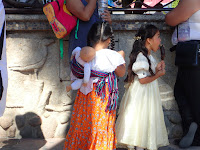As with most celebrations in Mexico, there was a parade,
ending at the zocalo (town square), with music, bands, dancing, street food, and
fireworks.
Our favorite part of the parade were the very small children as
“reenactors” -- the boys dress as revolucionarios, complete with bandoliers,
small toy rifles, and big black mustaches, while the girls dress as adelitas,
or soldederas – representing the women who fought alongside the men during the
Revolucion. (This rendition of La Adelita on YouTube is great background while
you read on! https://www.youtube.com/watch?v=LwpJEcXurLI)
 |
| A group of "reenactors" |
 |
| With baby on back. (Mark said we needed to buy the frozen banana concession!) |
The parade also had a queen and her court, lots of horses (including some that dance!) and youth sports teams who had dance routines and built pyramids (of people, that is)!
 |
| Parade princess |
 |
| After the parade in the zocalo |
The day after Dia de Revolucion, in Ajijic, marks the beginning of the "novena" for the local patron saint, San Andres. Nine days of celebration, parades, fireworks (starting at 6 am to “announce” morning mass, among other things) – but more of that in a later post.
Cultural Note: We found that there are only 3 days that are NOT part of a celebration between mid-November and the 2nd week of January! We haven’t figured out how they have the stamina for this! |
| Mark with Pancho Villa and Zapata |
We visited a small town called Mezcala, about 40 minutes away from Ajijic. We wanted to tour the Isla de Mezcala, famous for its role in the 1810 uprising against Spain. [Historical Sidebar: Padre Hidalgo issued his Grito de Dolores (Cry from Dolores) in 1810, calling for an end to Spanish rule of Mexico. It didn’t hurt that Napoleon Bonaparte had occupied Spain 2 years earlier, so the Spanish were a little distracted. Alas, the Padre, and 3 other leaders of the independence movement – Allende, Aldama, and Jimenez, were captured, killed, beheaded and their heads placed in large iron cages that hung for 10 years from the four corners of The Granary in Guanajuato. Pretty gruesome.]
The zocalo was full of people, food stalls and horses to rent. We saw a couple of gymnastics groups of young people, dancing and building (more) pyramids.
 But back to Isla de Mezcala. The island has had many residents over its history, but it is best known for the Insurrection period: about 1812, 800 indigenous Mexican fighters left the mainland for the small island in Lake Chapala, about 20 minutes by boat from town.
But back to Isla de Mezcala. The island has had many residents over its history, but it is best known for the Insurrection period: about 1812, 800 indigenous Mexican fighters left the mainland for the small island in Lake Chapala, about 20 minutes by boat from town.According to our guide, they successfully fought off a larger force of Spaniards for 4 years, first with rocks and other basic weapons, eventually fortified by captured guns and cannon. After 4 years of fighting, and losing, the Spanish cried “Tio!” (Uncle!), agreed to a truce, pardoned the remaining fighters, returned land to them which was the problem in the first place, and built a fort on the island, which the Spanish occupied until Mexican Independence was declared in 1821.
As we arrived, we saw several other boats full of locals, including one full of flowers. It turned out that we happened to be in Mezcala on the anniversary day, November 25, of the Spanish truce in 1816 (verifying Our Rule #1 – it’s better to be lucky than smart!).
Once on the island, we came upon a flag raising ceremony, and a large group of people gathered for a program, who then sang the national anthem.
 |
| Bruce, holding down the Fort |
In our next post, we’ll show you the San Andres festivities, which include death-defying firework displays!
(November 2017)






What a wonderful country it must be: Women treated like equals long before the 1970's, and people working together rather than trying to divide each other. The United States needs more than a few lessons from these celebrations. Keep on living, Dad+Linda. I love you and miss you!
ReplyDelete